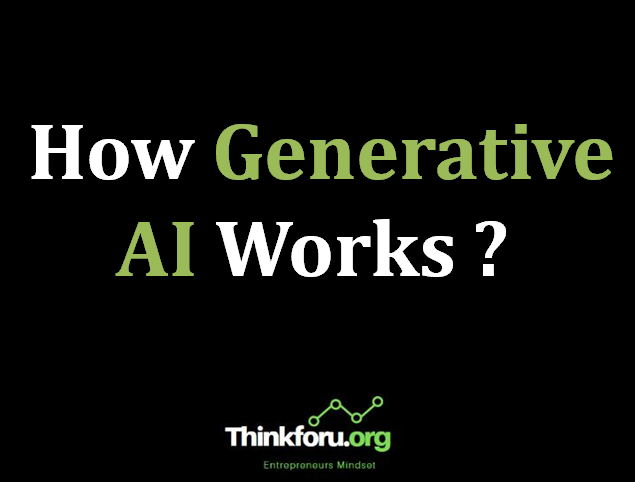How Generative AI Works ?
How Generative AI Works ?
Generative AI refers to artificial intelligence systems that can generate new, original content, such as text, images, or even music. One popular approach to generative AI is through the use of generative models, and one of the widely used types of generative models is Generative Adversarial Networks (GANs).
Here's a simplified explanation of how GANs work:
1. Generator:
The generator is a neural network that takes random noise as input and generates data, such as images or text. In the context of images, for example, the generator might create images that resemble real photographs.
2. Discriminator:
The discriminator is another neural network that evaluates input data and classifies it as real or fake. In the case of images, it might determine whether an image is a real photograph from a dataset or a generated one from the generator.
3. Training Process:
During training, the generator and discriminator are in a constant loop of competition. The generator tries to create more realistic data to fool the discriminator, while the discriminator aims to get better at distinguishing real from generated data.
4. Loss Function:
The performance of the generator and discriminator is evaluated using a loss function. The generator aims to minimize the chances of the discriminator correctly classifying generated data as fake, while the discriminator aims to correctly classify both real and generated data.
5. Adversarial Nature:
The adversarial aspect comes from the fact that the generator and discriminator are in a constant competition, each one trying to outsmart the other. This adversarial process helps the generator improve over time, creating more realistic data.
6. Convergence:
Ideally, the generator becomes so skilled at generating data that the discriminator can no longer distinguish between real and generated data. At this point, the model has reached a state of equilibrium, and the generated data is considered high-quality.
let's delve a bit deeper into the working principles of Generative Adversarial Networks (GANs):
1. Architecture:
Generator:
Typically, a neural network that takes random noise as input and transforms it into data (e.g., an image).
The generator's role is to create data that is indistinguishable from real data.
Discriminator:
Another neural network that evaluates input data and classifies it as real or fake.
The discriminator's role is to distinguish between real and generated data.
2. Loss Function:
Generator Loss:
Measures how well the generator is fooling the discriminator.
Encourages the generator to produce data that is more realistic.
Discriminator Loss:
Measures how well the discriminator is distinguishing between real and fake data.
Encourages the discriminator to correctly classify data.
3. Training Process:
Initialization:
Both the generator and discriminator are initialized with random weights.
Iterations:
In each iteration, the generator creates fake data, and the discriminator evaluates both real and fake data.
Backpropagation:
Based on the discriminator's feedback, both the generator and discriminator adjust their weights through backpropagation.
Adversarial Dynamics:
This back-and-forth process continues until the generator produces data that is realistic enough to deceive the discriminator.
4. Mode Collapse:
Challenge:
GANs may face mode collapse, where the generator produces a limited set of similar outputs, ignoring the full diversity of the real data distribution.
Mitigation:
Various techniques, like minibatch discrimination and adding noise to the input, can be employed to address mode collapse.
5. Hyperparameters:
Learning Rate:
Critical for balancing the training of the generator and discriminator.
Architecture Choices:
The depth and complexity of the neural networks in the generator and discriminator impact performance.
6. Applications:
Image Generation:
GANs have been notably successful in generating high-quality images, even photorealistic faces.
Style Transfer:
GANs can be used for transferring artistic styles from one image to another.
Data Augmentation:
GANs can augment datasets, creating additional diverse examples for training other models.
7. Challenges:
Training Stability:
GANs can be challenging to train, and the stability of training is an ongoing research area.
Evaluation Metrics:
Assessing the quality of generated samples is not always straightforward.
Generative models are not limited to GANs; other approaches include Variational Autoencoders (VAEs) and autoregressive models like OpenAI's GPT (Generative Pre-trained Transformer). Each of these models has its own strengths and weaknesses, and the choice depends on the specific task and the characteristics of the data being generated.
Generative AI, and GANs in particular, have shown remarkable capabilities in various domains, but they also come with challenges that researchers continue to address. Advances in generative models contribute to applications in art, entertainment, data synthesis, and more.
More Related to Generative AI
What is Generative AI Google
What is Generative AI vs Discriminative AI
